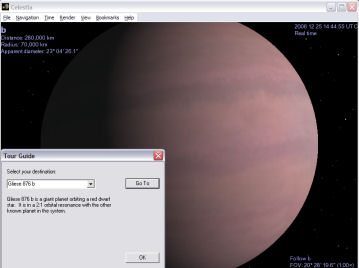That's Why They Call It Space
Recently I've posted a couple entries on relative sizes of astronomical objects. The first entry included a link to a kind of slide show that steps us from the big (by human standards) to the very big, to the extremely huge. The second entry embedded a video that takes us on a similar path from smaller to larger objects. The second entry prompted some interesting commentary. From Stephen:
Does anyone else get a little... queasy... contemplating magnitudes like this?
Sort of gets my heart rate up like staring over the side of a cliff or something.
Maybe it's just me.
Which led to this response from Ivan Kirgin's brother:
the space between these things is literally orders of magitude bigger, though. and don't get me started about intergalactic distaces
So how to experience these distances? Eventually, I'm planning to send thousands of digital copies of myself out across the universe in very small space probes, which will also contain millions of other digitized folks, the sum of human knowledge, and a few seed tools for establishing a human presence in any location deemed attractive and appropriate -- with the thought that one day a bunch of us will be able to get back together and share the experience. But, heck, that trip is decades or centuries away. And any reunion would probably only be eons from now. (BTW, Stephen, this is the sort of talk that makes me a little dizzy. I do it to myself!)
So what to do in the mean time?
Well, I just happened to Stumble upon Celestia the other day. I realized after downloading it and playing with it for a while, that it had actually come up before in one of Stephen's earlier threads (here and here) about good desktop tools for exploring the universe.
With Celestia, you can view astronomical objects at various zoom levels and also travel from one object to another. This helps to capture the magnitude of the distances involved, at least indirectly. For example, when viewing Earth, I was surprised after pulling back a bit that I couldn't see the moon. It was startling to realize how far back I needed to zoom in order to bring the moon into view. I had a similar experience visiting Alpha Centauri. One tends to picture the two stars just sort of sitting right on top of each other. Of course, that isn't how it is. Those two stars are, by our way of loooking at things, really far apart. The only thing that makes them, relatively, close together is how much farther apart everything else is. And of course, that's not even scratching the surface of the integralalctic distances that Ivan's brother was talking about.
Anyhow, if you want to get a better feel for interplanetary and interstellar distances, or if you'd be interested, say, in visiting an extrasolar planet...

...you might want to give Celestia a try. It's a free download.
Comments
My first memory of being afraid of anything--at about age 2 and a half or 3--was trying to fathom space. I remember visualizing the earth hanging there in that terrible void. I hid behind chairs and cried. I was a very strange child.
Posted by: Kathy![[TypeKey Profile Page]](http://www.blog.speculist.com/nav-commenters.gif) |
December 30, 2006 09:41 AM
|
December 30, 2006 09:41 AM